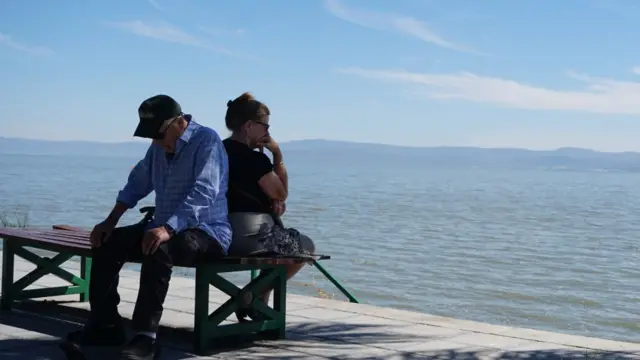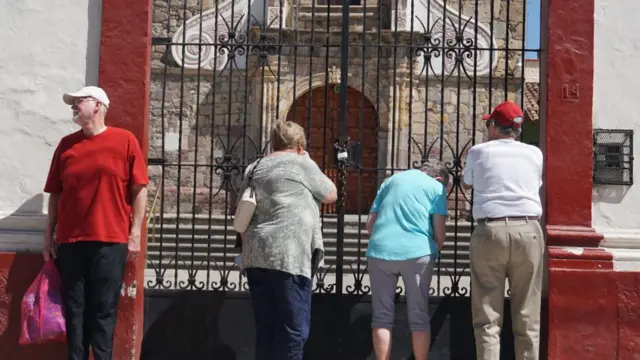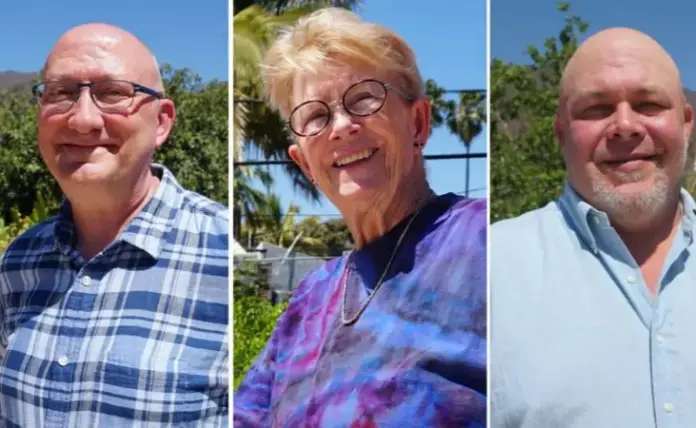In the northern part of the lake, there are a dozen small towns, known as the Chapala Riverbank, where life is like an oasis: the calm and silence emanating from the lake spread, and the violence that is so often talked about in other regions of the state of Jalisco is not felt here.
One of these towns is Ajijic, which in the ancient Mexican language, Nahuatl, means “place where water springs forth.” And indeed: here, the water makes the breezes cool, less dry, and temperatures, even in summer, do not exceed 30°C.
The first American tourist arrived in Ajijic, 50 km from Guadalajara, one of the three most important cities in the country, in the 19th century.
Today, more than 10,000 Americans live in what they themselves call, with pride and a touch of humor, “the most gringo town in Mexico.”
And they spend their time walking along the majestic boardwalk, teaching English to Mexicans, volunteering, taking art or pottery classes, or participating in “gringo-friendly” events like trivia nights.
“I live like a king,” says Keith Starling, an American who retired here four years ago. “It seems like there was some divine intervention to bring me here,” he adds, dressed in a Yucatecan guayabera.
Most of these Americans—plus a few Canadians—are retirees who get more out of their pensions here. Since the pandemic, however, the average age has been dropping, driven by young migrants who work remotely or want a different lifestyle.
“People in the US ask me all the time if I’m safe here,” says James Burns, a historian in his 50s who arrived five years ago. “And the truth is, I feel much safer in Mexico than I did in the United States.”
The “Gringos” in Mexico
According to official data, some six million Americans live outside the country. And almost 20% of them are in Mexico.
Many Mexicans who migrated north decades ago had children there and returned, so a large portion of the million Americans in Mexico actually have Mexican roots.
But there are also Americans who have migrated south, in what some industry jargon has called “reverse migration”; that is, flows contrary to the more common migration.
Many Mexican towns are, therefore, “full of gringos”: in Tulum and Cancún, two Caribbean paradises, there are 15,000; in San Miguel de Allende, a colonial city in the mountains, there are 10,000; and in Baja California, a peninsula in the Pacific Ocean on the northern border, official figures show 130,000 Americans.
But Ajijic is the only place where the northern neighbors—mostly white, retired, and with little Spanish—are as numerous as the Mexicans.
“Sixty percent of my clients are Americans,” says Noé López, a real estate agent in the area. “And there are those who come to buy and those who come to rent, but everyone here lives like they’re rich: they go to restaurants, they have cleaning services.”
They are middle or lower class north of the border, and upper class in the south.
“We know we’re privileged,” says Craig Purcell-Beard, a St. Louis native, referring to their purchasing power. “That’s partly why so many people are involved in volunteering—not out of guilt, but out of a desire to get involved.”
Some Mexicans fear the impact of this migration on local prices and culture. “Out with the gringos” graffiti in neighborhoods like La Condesa and La Roma in Mexico City has generated the perception of anti-immigration sentiment.
But in Ajijic, where American migration has been going on for at least seven decades, there’s no such complaint about so-called gentrification.
“I don’t feel like a stranger, but rather a welcome guest,” says Burns.
In all the conversations I had with Americans in Ajijic, I found more criticism of their own country—a profound criticism, which recent news seems to confirm—than a quest to make Mexico a “more gringo” place.
Burns himself says that the decision to leave—which “wasn’t easy,” because he lost 85% of his income—was “for mental health reasons.”
“I began to feel like I enjoyed leaving the house less and less, even for everyday activities like walking the dog or going to the grocery store, because of the way people treated each other,” he says.
K.J. Purcell-Beard, who immigrated with her boyfriend Craig and started a YouTube channel to refute the “lies” told about Mexico, explains that “in the US, we’re taught from childhood to work hard, to give our all, and we’re told that with that, you’ll get everything you want.”
Craig, her partner, adds: “The culture, the economy, the system in general became increasingly toxic and ended up expelling me; staying was no longer an option; if I had stayed, I’d be homeless now.”
And then Mexico, says K.J., emerged as an alternative: “Mexicans, culturally, have a natural predisposition not to succumb to materialism; family comes first, they spend time with their neighbors; and they’ll find a way to pay their bills, yes, but I don’t see this constant need to buy the latest iPhone.”

When I asked why they came, many mentioned the climate, the prices, the proximity, but all, without exception, agreed, distressed, on a deeper reflection: values.
“The white culture that is now in power in the U.S. has the mentality that everything they do is right and that everyone else has to assimilate it,” Susan Brewer, a Californian over 60, told me.
“Going back to my country doesn’t feel as good as it used to.”
Donald Trump’s rise to power has meant, among many other things, but perhaps more than anything else, a cultural revolution about the values of community, solidarity, and respect that these migrants seem to find more in Mexico than at home.
“Mexicans value what’s on the inside before what’s on the outside of people,” says KJ.
And Burns adds: “People in Mexico live their lives masterfully; I wish Americans could do the same.”
In the mirror of Lake Chapala, one sees a new life, an arrival, but also a departure, the exodus of a country that, says Burns, “is regressing, while Mexico is progressing.”

Source: bbc




